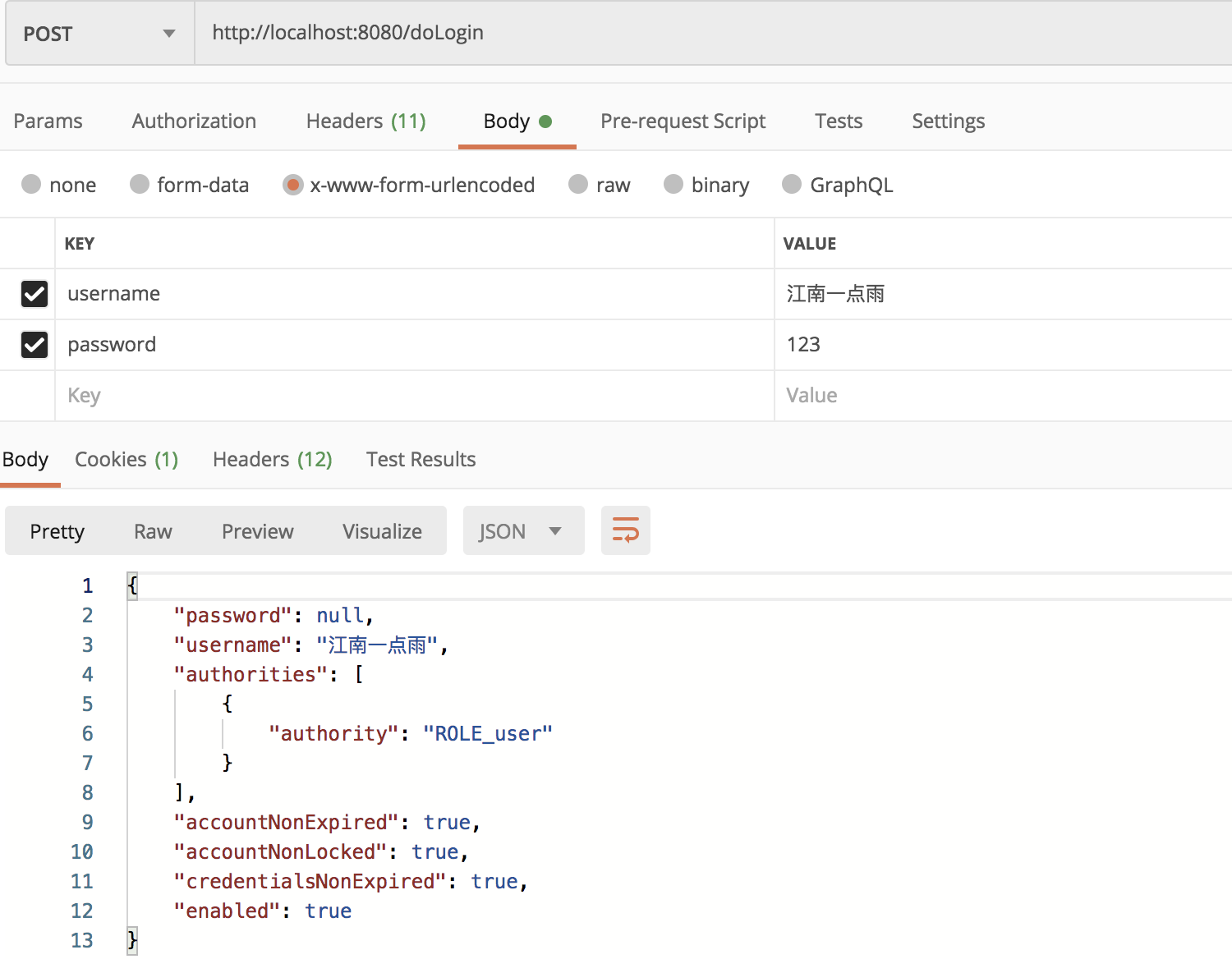通过前面四篇文章的介绍,Spring Security 中的登录认证我们就先告一个小小段落。在本系列未来的教程中,我们还会继续涉及到 Spring Security 中的登录认证问题,这个我们以后再说。
本系列前面四篇文章给小伙伴们列一个索引出来,大家可以参考:
挖一个大坑,Spring Security 开搞!
松哥手把手带你入门 Spring Security,别再问密码怎么解密了
手把手教你定制 Spring Security 中的表单登录
Spring Security 做前后端分离,咱就别做页面跳转了!统统 JSON 交互
好了,今天我们就通过一个简单的案例来看看 Spring Security 中的授权操作。
1.授权
所谓的授权,就是用户如果要访问某一个资源,我们要去检查用户是否具备这样的权限,如果具备就允许访问,如果不具备,则不允许访问。
2.准备测试用户
因为我们现在还没有连接数据库,所以测试用户还是基于内存来配置。
基于内存配置测试用户,我们有两种方式,第一种就是我们本系列前面几篇文章用的配置方式,如下:
@Overrideprotected void configure(AuthenticationManagerBuilder auth) throws Exception {auth.inMemoryAuthentication().withUser("javaboy").password("123").roles("admin").and().withUser("江南一点雨").password("123").roles("user");}
复制代码
这是一种配置方式。
由于 Spring Security 支持多种数据源,例如内存、数据库、LDAP 等,这些不同来源的数据被共同封装成了一个 UserDetailService 接口,任何实现了该接口的对象都可以作为认证数据源。
因此我们还可以通过重写 WebSecurityConfigurerAdapter 中的 userDetailsService 方法来提供一个 UserDetailService 实例进而配置多个用户:
@Beanprotected UserDetailsService userDetailsService() {InMemoryUserDetailsManager manager = new InMemoryUserDetailsManager();manager.createUser(User.withUsername("javaboy").password("123").roles("admin").build());manager.createUser(User.withUsername("江南一点雨").password("123").roles("user").build());return manager;}
复制代码
两种基于内存定义用户的方法,大家任选一个。
3.准备测试接口
测试用户准备好了,接下来我们准备三个测试接口。如下:
@RestControllerpublic class HelloController {@GetMapping("/hello")public String hello() {return "hello";}@GetMapping("/admin/hello")public String admin() {return "admin";}@GetMapping("/user/hello")public String user() {return "user";}}
复制代码
这三个测试接口,我们的规划是这样的:
/hello 是任何人都可以访问的接口
/admin/hello 是具有 admin 身份的人才能访问的接口
/user/hello 是具有 user 身份的人才能访问的接口
所有 user 能够访问的资源,admin 都能够访问
注意第四条规范意味着所有具备 admin 身份的人自动具备 user 身份。
4.配置
接下来我们来配置权限的拦截规则,在 Spring Security 的 configure(HttpSecurity http) 方法中,代码如下:
http.authorizeRequests().antMatchers("/admin/**").hasRole("admin").antMatchers("/user/**").hasRole("user").anyRequest().authenticated().and()......
复制代码
这里的匹配规则我们采用了 Ant 风格的路径匹配符,Ant 风格的路径匹配符在 Spring 家族中使用非常广泛,它的匹配规则也非常简单:
|通配符|含义|
|:----|:-----|
|**|匹配多层路径|
|*|匹配一层路径|
|?|匹配任意单个字符|
上面配置的含义是:
如果请求路径满足 /admin/** 格式,则用户需要具备 admin 角色。
如果请求路径满足 /user/** 格式,则用户需要具备 user 角色。
剩余的其他格式的请求路径,只需要认证(登录)后就可以访问。
注意代码中配置的三条规则的顺序非常重要,和 Shiro 类似,Spring Security 在匹配的时候也是按照从上往下的顺序来匹配,一旦匹配到了就不继续匹配了,所以拦截规则的顺序不能写错。
另一方面,如果你强制将 anyRequest 配置在 antMatchers 前面,像下面这样:
http.authorizeRequests().anyRequest().authenticated().antMatchers("/admin/**").hasRole("admin").antMatchers("/user/**").hasRole("user").and()
复制代码
此时项目在启动的时候,就会报错,会提示不能在 anyRequest 之后添加 antMatchers:
这从语义上很好理解,anyRequest 已经包含了其他请求了,在它之后如果还配置其他请求也没有任何意义。
从语义上理解,anyRequest 应该放在最后,表示除了前面拦截规则之外,剩下的请求要如何处理。
在拦截规则的配置类 AbstractRequestMatcherRegistry 中,我们可以看到如下一些代码(部分源码):
public abstract class AbstractRequestMatcherRegistry<C> {private boolean anyRequestConfigured = false;public C anyRequest() {Assert.state(!this.anyRequestConfigured, "Can't configure anyRequest after itself");this.anyRequestConfigured = true;return configurer;}public C antMatchers(HttpMethod method, String... antPatterns) {Assert.state(!this.anyRequestConfigured, "Can't configure antMatchers after anyRequest");return chainRequestMatchers(RequestMatchers.antMatchers(method, antPatterns));}public C antMatchers(String... antPatterns) {Assert.state(!this.anyRequestConfigured, "Can't configure antMatchers after anyRequest");return chainRequestMatchers(RequestMatchers.antMatchers(antPatterns));}protected final List<MvcRequestMatcher> createMvcMatchers(HttpMethod method,String... mvcPatterns) {Assert.state(!this.anyRequestConfigured, "Can't configure mvcMatchers after anyRequest");return matchers;}public C regexMatchers(HttpMethod method, String... regexPatterns) {Assert.state(!this.anyRequestConfigured, "Can't configure regexMatchers after anyRequest");return chainRequestMatchers(RequestMatchers.regexMatchers(method, regexPatterns));}public C regexMatchers(String... regexPatterns) {Assert.state(!this.anyRequestConfigured, "Can't configure regexMatchers after anyRequest");return chainRequestMatchers(RequestMatchers.regexMatchers(regexPatterns));}public C requestMatchers(RequestMatcher... requestMatchers) {Assert.state(!this.anyRequestConfigured, "Can't configure requestMatchers after anyRequest");return chainRequestMatchers(Arrays.asList(requestMatchers));}}
复制代码
从这段源码中,我们可以看到,在任何拦截规则之前(包括 anyRequest 自身),都会先判断 anyRequest 是否已经配置,如果已经配置,则会抛出异常,系统启动失败。
这样大家就理解了为什么 anyRequest 一定要放在最后。
5.启动测试
接下来,我们启动项目进行测试。
项目启动成功后,我们首先以 江南一点雨的身份进行登录:
登录成功后,分别访问 /hello,/admin/hello 以及 /user/hello 三个接口,其中:
/hello 因为登录后就可以访问,这个接口访问成功。
/admin/hello 需要 admin 身份,所以访问失败。
/user/hello 需要 user 身份,所以访问成功。
具体测试效果小伙伴们可以参考松哥的视频,我就不截图了。
按照相同的方式,大家也可以测试 javaboy 用户。
6.角色继承
在前面松哥提到过一点,所有 user 能够访问的资源,admin 都能够访问,很明显我们目前的代码还不具备这样的功能。
要实现所有 user 能够访问的资源,admin 都能够访问,这涉及到另外一个知识点,叫做角色继承。
这在实际开发中非常有用。
上级可能具备下级的所有权限,如果使用角色继承,这个功能就很好实现,我们只需要在 SecurityConfig 中添加如下代码来配置角色继承关系即可:
@BeanRoleHierarchy roleHierarchy() {RoleHierarchyImpl hierarchy = new RoleHierarchyImpl();hierarchy.setHierarchy("ROLE_admin > ROLE_user");return hierarchy;}
复制代码
注意,在配置时,需要给角色手动加上 ROLE_ 前缀。上面的配置表示 ROLE_admin 自动具备 ROLE_user 的权限。
配置完成后,重启项目,此时我们发现 javaboy 也能访问 /user/hello 这个接口了。
好了,今天就和小伙伴们说这么多.
感谢小伙伴们的阅读,如果觉得有用,毫不犹豫的点个在看鼓励下松哥,我会以风驰电掣般的速度快速更完这个系列~
好了 ,本文就说到这里,本文相关案例我已经上传到 GitHub ,大家可以自行下载:https://github.com/lenve/spring-security-samples















评论